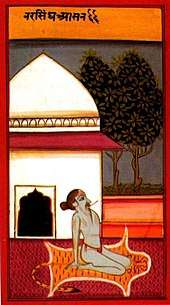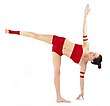Simhasana
Simhasana (Sanskrit: सिंहासन; IAST: Siṁhāsana) or Lion Pose[1] is an asana in hatha yoga and modern yoga as exercise.

Simhasana
Etymology and origins

"Narasimhasana" from an illustrated manuscript of the Joga Pradipika, 1830
The name comes from the Sanskrit words simha (सिंह), meaning "lion", and āsana (आसन), meaning "posture" or "seat".[2] The pose has also been named Narasimhasana,[3] from Sanskrit नरसिंह Narasimha, a lion-man avatar of the god Vishnu.[4] The posture is described in the tenth century Vimānārcanākalpa.[5]
Description
The asana resembles a seated lion, hence the name. The practitioner kneels as in Virasana and makes a facial expression to resemble a lion.
See also
References
- "Yoga Journal - Lion Pose". Retrieved 2011-07-03.
- Sinha, S. C. (1996). Dictionary of Philosophy. Anmol Publications. p. 18. ISBN 978-81-7041-293-9.
- Bühnemann, Gudrun (2018). 84 Asanas in Yoga. D.K.Printworld. p. 59 (plate 68).
- Williams, George M. (2008). Handbook of Hindu Mythology. Oxford University Press. p. 223. ISBN 978-0-19-533261-2.
- Mallinson, James; Singleton, Mark (2017). Roots of Yoga. Penguin Books. pp. 100–101. ISBN 978-0-241-25304-5. OCLC 928480104.
Further reading
- Iyengar, B. K. S. (1 October 2005). Illustrated Light On Yoga. HarperCollins. ISBN 978-81-7223-606-9. Retrieved 9 April 2011.
- Saraswati, Swami Janakananda (1 February 1992). Yoga, Tantra and Meditation in Daily Life. Weiser Books. ISBN 978-0-87728-768-1. Retrieved 11 April 2011.
- Saraswati, Swami Satyananda (1 August 2003). Asana Pranayama Mudra Bandha. Nesma Books India. ISBN 978-81-86336-14-4. Retrieved 9 April 2011.
- Saraswati, Swami Satyananda (January 2004). A Systematic Course in the Ancient Tantric Techniques of Yoga and Kriya. Nesma Books India. ISBN 978-81-85787-08-4. Retrieved 9 April 2011.
External links
This article is issued from Wikipedia. The text is licensed under Creative Commons - Attribution - Sharealike. Additional terms may apply for the media files.
_from_Jogapradipika_1830_(detail).jpg)

